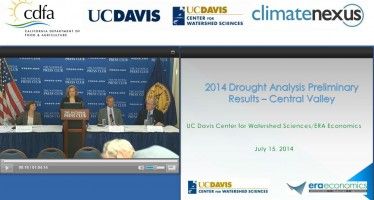Initiative would revive redevelopment agencies

 If it were a movie, it might be called “Revenge of the JEDI: the Redevelopment Empire Strikes Back.” It’s the California Jobs and Education Development Initiative (JEDI), which would enable the revival of the 425 redevelopment agencies eliminated in 2011 by Gov. Jerry Brown and the California Legislature.
If it were a movie, it might be called “Revenge of the JEDI: the Redevelopment Empire Strikes Back.” It’s the California Jobs and Education Development Initiative (JEDI), which would enable the revival of the 425 redevelopment agencies eliminated in 2011 by Gov. Jerry Brown and the California Legislature.
The initiative liberalizes the definition of “blight” to include areas where the unemployment rate exceeds the national or statewide rate. That could result in 85 percent of California’s counties being declared blighted and eligible for redevelopment.
The initiative is spearheaded by Californians for Jobs and Economic Development. The group incorporated a year ago, according to corporationwiki, but it does not have a website.
Its president is Santa Ana’s mayor for the past 20 years, Miguel Pulido. He also happens to be under investigation by the state Fair Political Practices Commission for allegedly profiting $197,000 from a real estate transaction in exchange for giving an auto parts store an exclusive city contract, according to the Los Angeles Times.
Cities donate $110,000
Several California cities donated a combined $110,000 to research the initiative. They include Ontario ($50,000), San Jose ($25,000), Anaheim ($25,000) and Pittsburg ($10,000), according to public records compiled by The California Alliance to Protect Private Property Rights, which is opposed to the initiative.
Some of the contributions never appeared on a city council or redevelopment successor agency agenda, said Nick Mirman, CAPPPR grassroots coordinator.
“Californians will be shocked to learn that taxpayer dollars that would otherwise go to public safety, parks and roads are being used to qualify a statewide initiative,” he said. “What’s more, the initiative is designed to make it easier for government to seize homes and small businesses by eminent domain so that it can be given to politically connected developers on the cheap … to build luxury hotels, golf courses and strip malls.”
Pittsburg Assistant City Manager Garrett Evans said that the city’s donation was not agendized because the city manager has the discretion to spend more than that amount, and that a council subcommittee had approved it.
Redevelopment ‘an incredible tool’
“Redevelopment was an incredible tool for Pittsburg,” said Evans. “Our community used redevelopment to build school facilities, fire stations, library improvements, parks, renovate historic structures, rebuild roads and infrastructure, and build affordable housing. Pittsburg’s crime rate is at its lowest point in 50 years because redevelopment was used to eliminate blight and unsafe buildings.
“Through redevelopment, the City worked with industrial corporations to locate and expand in our community, meaning our job base and wages increased. Our downtown was vacant and empty when I began working here 17 years ago. Now it is vibrant and full with pedestrians and restaurants. Redevelopment is a local, community-based program. Local residents decide what they want to accomplish in their neighborhood through a public process and a redevelopment plan.”
Cash cows
Redevelopment agencies had been cash cows for cities, giving them an extra $5 billion from the $50 billion that Californians pay in property taxes annually, according to an LAO analysis of the initiative. Much of the $5 billion would have gone to other governmental agencies, including fire departments, libraries and schools.
Passage of the redevelopment initiative would result in “increased resources for local redevelopment activities, growing to several billion dollars more per year, resulting in decreased resources for state and other local government activities of the same amount,” the LAO study concludes.
California’s unemployment rate has dropped to 8.5 percent from the 11.3 percent it was at when redevelopment agencies began to be dissolved in February 2012. Despite that, the initiative touts job creation as one of redevelopment’s main benefits.
Initiative findings
The initiative makes the following assumptions:
- “California has one of the highest unemployment rates in the nation and is struggling to recover from the Great Recession.
- “High unemployment is the new blight, which quickly becomes the old blight – poverty, neighborhood deterioration and crime.
- “High unemployment reduces tax revenue to state and local governments and negatively impacts funding for our cash-strapped schools.
- “Tax-increment financing [provided through redevelopment agencies] allows local governments to use locally generated property tax revenues to create jobs, build affordable housing and rebuild neighborhoods.
- “Tax-increment financing originated in California more than 50 years ago, and most other states have since adopted this powerful tool for creating jobs and rebuilding neighborhoods.
- “In 2012, California eliminated tax-increment financing for local housing and development projects, resulting in the considerable loss of 300,000 jobs, including 170,000 construction jobs, and more than $41 billion in economic activity.
- “JEDI will allow cities throughout California to use locally generated property tax revenues to create jobs, building affordable housing, rebuild neighborhoods and fund public schools.
- “JEDI will put thousands of Californians back to work and generate billions of dollars in new tax revenue for public schools without raising taxes or increasing state debt.”
Jobs claim in dispute
A study commissioned by the California Redevelopment Association concluded that redevelopment was responsible for the creation of about 304,000 jobs in 2006-07.
The LAO disputed that claim in a 2011 study titled, “Should California End Redevelopment Agencies?” (The LAO’s answer was “yes.”)
“While redevelopment leads to economic development within project areas, there is no reliable evidence that it attracts businesses to the state or increases overall regional economic development,” the study found. “[R]edevelopment may cause some geographic shifts in economic development, but does not increase the overall amount of economic activity in a region.
“The independent research we reviewed found little evidence that redevelopment increases jobs. Studies in Illinois and Texas, for example, found that their redevelopment programs did little more than displace commercial activity that would have occurred elsewhere in the region.”
The LAO said that the CRA study “vastly overstates the employment effects of redevelopment areas” due to three flaws:
- “It assumes that redevelopment agencies participate in all project area construction – even if the redevelopment agency was not a participant. “We find implausible the report’s implicit assumption that no construction with solely private financing would have occurred within a redevelopment area in the absence of the redevelopment agency.”
- “It assumes that private and public entities participating in redevelopment agency projects would not invest in other projects. Most redevelopment agency projects include significant financing from private investors or other public agencies. The CRA implicitly assumes that these private and public partners would not invest in other economic activities in the state.
- “It assumes other local agencies’ use of property tax revenues would not yield economic benefits. The property tax revenues that currently support redevelopment would flow over time to schools and other local agencies in the county. The CRA implicitly assumes that these other local agencies’ use of property tax revenues would not result in any economic activity.”
Time Structures, the research firm that performed the CRA study, wrote a point-by-point rebuttal to the LAO’s contentions:
- “The construction expenditures included in the impact analysis were limited to those that involved agency participation. The study actually includes 32 percent of the total construction activity that occurred within the project areas during the 2006-07 fiscal year. Had the LAO exercised due diligence prior to offering their conclusion on this point, they would have been obligated to take a very different position.
- “Redevelopment projects do leverage a significant amount of private capital – in our study we found that for each public dollar invested in a project, six private dollars are invested. The LAO seems to imply that this private capital is just sitting there awaiting a project; however, construction involves a good deal of borrowed capital. Construction loans are difficult to get for what are perceived as risky projects in blighted areas.
- “The economic benefits estimated in the study were limited to those arising from the redevelopment-assisted construction activity only. No benefits were calculated for the direct employment and income of agency employees or the multiplier effect arising from that income. We make no assumptions about any economic activity of other local agencies since we didn’t study such a transfer.”
Effect on education
There is also a debate on whether the Jobs and Education Development Initiative would help education.
The LAO analysis of the initiative states that there would be no effect on schools in the short term because the schools’ funding deficit due to shifting fund back to redevelopment would be made up from the state general fund. “Therefore, the measure likely would increase state education costs by around $1 billion per year, but would have little or no net effect on nonbasic aid districts,” according to the LAO.
Over the long term, funding for some school and community college districts “could be reduced potentially by a few hundred million dollars to a few billion dollars per year,” the LAO states.
Responded the initiative’s campaign spokesman, Stu Mollrich, “We believe that the initiative will increase funding for education by stimulating job creation, which increases revenues for the state’s general fund.”
The League of California Cities has not taken a position on the initiative, according to Executive Director Chris McKenzie. But if it passed, few organizations would be happier.
“We were big supporters of the former redevelopment program, which studies showed provided 300,000 private sector jobs and $2 billion in state and local tax revenue each year,” McKenzie said. “But it no longer exists, and most cities have had to devote countless hours and resources to the unfortunate dissolution process.”
‘Significant expansion of government power’
The Institute for Justice, a pro-property rights law firm, released an analysis that called the redevelopment initiative “one of the most significant expansions of government power in decades.”
“Redevelopment in California had nothing to do with creating jobs or improving education,” said IJ attorney Bill Maurer in a statement. “Resurrecting it would endanger private property and undermine the state’s fiscal stability. … It would divert money from schools and community colleges and give it to unelected governmental agencies and their politically connected business allies. The governor and the state legislature were right to end this system in 2011.”
State Sen. Jim Nielsen, R-Gerber, agreed. “California property owners were finally able to rest easy once the governor did away with redevelopment agencies in 2011,” he said. “Reviving this system again exposes homes, small businesses and places of worship to eminent domain abuse.”
“Prior to being dissolved in 2011, redevelopment agencies turned California into one of the worst states in the nation for eminent domain abuse,” according to the IJ. “Tens of thousands of acres of property were declared blighted and subject to condemnation. Those displaced were often poor minorities and the elderly.”
The initiative needs 504,760 valid signatures to qualify for the ballot. Supporters have until July 21, 2014 to collect the signatures.
Related Articles
Redistricting Dogfight Looms in O.C.
JUNE 15, 2011 By JOHN SEILER The lines on the maps just released by the California Citizens Redistricting Commission could
CA secessionists raise eyebrows with Russia ties
The campaign to place California secession on the ballot next election year entered uncertain waters as news broke that
Will CA groundwater regulation bring shortages?
One area of California that largely has remained free of regulation is groundwater. Although state courts “adjudicate” groundwater rights




